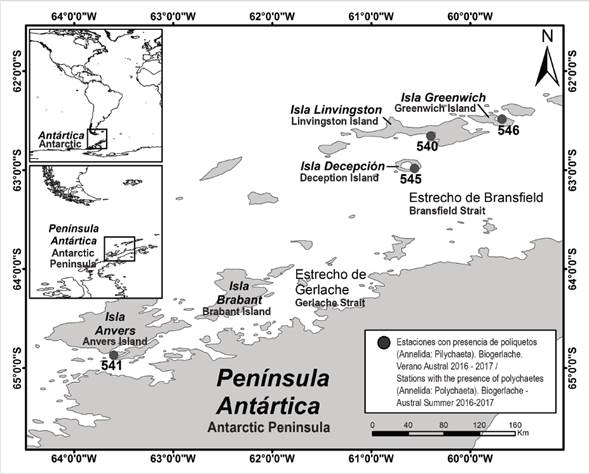Annelids (phylum Annelida) are a substantial group of animals, commonly referred as segmented worms (Rouse and Pleijel, 2001). Polychaeta Grube, 1850, represents the most diverse class of this phylum, composed of marine organisms predominantly, with some terrestrial and freshwater representatives. In the sea they are present in all sediments from intertidal zones to great depths, which makes them essential for the structure, production, dynamics, and health of the marine benthos (Báez and Ardila, 2003). Polychaetes play a fundamental role in the marine benthic food chain, not only in recycling organic matter within sediments and decomposing plant material, but also as prey of other organisms (Beesley et al., 2000). Its abundance, richness, variety of feeding types, and permanence in the sediment, makes them excellent indicators of environmental disturbance (Salazar-Vallejo, 2000). An example is the presence of Capitella species and some cirratulids that may indicate contamination by organic enrichment (Grassle and Grassle, 1974; Warren, 1981).
Taxonomic study of polychaetes and annelids in general, can be difficult and requires considerable expertise in the group. Within the Polychaeta Class around 23,000 species have been described but approximately 13,000 are considered accepted (WoRMS, 2020). Particularly for Antarctica, 765 polychaete species have been registered, but 543 are considered accepted (Clarke and Johnston, 2003; Sicinski et al., 2020). This work records the taxonomic information, as well as the abundance and frequency of occurrence of the benthic polychaetes collected in the III Expedición “Admiral Padilla” verano austral 2016-2017, as part of the project Biodiversity and oceanographic conditions of the Gerlache Strait “Biogerlache - Antartica” of the Institute of Marine and Coastal Research - Invemar.
The study area is in the north of Antarctic Peninsula with three stations located near Greenwich, Livingston, and Deception islands. This is located to the south Shetland Islands archipelago between the Drake Pass and the Bransfield Strait, about 120 km from Antarctic peninsula; and one station located south of Anvers Island in the Gerlache Strait, about 40 km from Antarctic peninsula (Figure 1). The benthic samples were collected with a 500 g shipek-type dredger, treated with magnesium chloride and fixed with 10 % formalin with bengal rose. In the laboratory, each sample was washed through a 500 µm sieve with abundant water to retain the macrofauna and the subsequent separation of the polychaetes. The material is in identification process in the Annelid collection of the Marine Natural History Museum of Colombia (MHNMC) - Makuriwa, of Invemar.

Figure 1 Study area: Stations with the presence of benthic polychaetes (Annelida: Polychaeta), collected for “Biogerlache - Antarctic” project, austral summer (2016-2017).
A total of 326 individuals of 12 polychaete families and one suborder were quantified, included into two subclasses (Errantia and Sedentaria), two infraclasses and five orders (Table 1, Figure 2). Cirratulidae (110 individuals) and Paraonidae (105 ind.) were the most abundant and frequent, being in the four analyzed stations. Nereididae, Orbiniidae, Serpulidae, and Sigalionidae were the less abundant and frequent with one individual, respectively About the sampled stations, E546 located on Greenwich Island with a 29 m depth had the greatest number of individuals (123), most of the family Cirratulidae, and fewer families (3); Station E545 located on Deception Island at 89 m depth registered the least abundance with 22 individuals of six families. On the other hand, at station E540 with 49 m depth, had the greatest number of families (9), besides the suborder Terebelliformia (only registered in this station), and 80 individuals; and in station E541 located in Gerlache strait at 54 m depth, had 101 individuals included in nine families.

Figure 2 Benthic polychaetes for “Biogerlache - Antarctic” project, austral summer 2016 - 2017: Errantia: A. Dorvilleidae (500 μm), B. Sigalionidae (500 μm), C. Nereididae (1 mm), D. Syllidae (200 μm); Sedentary: E. Serpulidae (200 μm), F. Apistobranchidae (500 μm), G. Spionidae (500 μm), H. Cirratulidae (200 μm), I. Terebelliformia (200 μm), J. Capitellidae (500 μm), K. Maldanidae (500 μm), L. Orbiniidae (1 mm), M. Paraonidae (200 μm).
Table 1 Taxonomic classification, relative abundance (RA) and frequency of Occurrence (FO) of benthic polychaetes collected for “Biogerlache - Antarctic” project, austral summer (2016-2017).

A preliminary taxonomic work has allowed the identification of the genera Apistobranchus (family Apistobranchidae - 2 deteriorated specimens), Capitella (family Capitellidae - 13 specimens) and Neanthes (family Nereididae - one juvenile specimen), as well as two morphotypes of the family Cirratulidae, and three morphotypes of the families Dorvilleidae, Maldanidae, Paraonidae, Syllidae, and the suborder Terebelliformia. It is important to mention that, despite many of the specimens collected are incomplete or deteriorated, additional and more detailed analyzes are necessary to consider greater precision in taxonomic identity of samples. Evenly, we recommended evaluating different collection methodologies for future expeditions that allows the required preservation of the specimens for morphological and molecular analyzes, to advance in the knowledge of polychaete taxa typical the area. The present work shows in general terms the importance of this biological group of the composition and benthic structure of austral bottoms.











 text in
text in 



